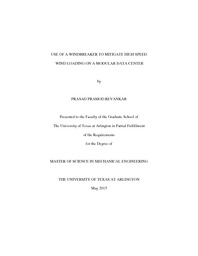
ATTENTION: The works hosted here are being migrated to a new repository that will consolidate resources, improve discoverability, and better show UTA's research impact on the global community. We will update authors as the migration progresses. Please see MavMatrix for more information.
Show simple item record
| dc.contributor.author | Revankar, Prasad Pramod | en_US |
| dc.date.accessioned | 2015-07-31T22:10:24Z | |
| dc.date.available | 2015-07-31T22:10:24Z | |
| dc.date.submitted | January 2015 | en_US |
| dc.identifier.other | DISS-13217 | en_US |
| dc.identifier.uri | http://hdl.handle.net/10106/25141 | |
| dc.description.abstract | The data centers that are located in open regions are subjected to various environmental risks. Earthquakes and very strong winds have the greatest effect on the structural integrity of the data centers. As the wind blows against the external structure, there is a buildup of pressure against the external structure which is translated to the supporting structure. Certain components of the data center like the inlet and exhaust dampers cannot withstand high wind speeds. Various kinds of fences have been used as windbreakers to prevent wind induced damage to objects. A windbreaker basically acts as a barrier to the upstream wind and reduces the mean velocity of air downstream of the windbreaker, thereby reducing the wind loading on the objects situated behind the fence. The distance of the windbreaker from the modular data center and porosity of the windbreaker are main parameters that determine the level of wind speed reduction across the windbreaker. The aim of this computational investigation is to obtain the optimum values of these design parameters, for reducing sustained wind speed of 44.7 m/s (100 mph) to 9 m/s (20 mph) average velocity in the direction normal to wall, at a distance of 0.3 m (1 ft.) from the wall of the modular data center (MDC).A 3D model of a windbreaker and an enclosure of the modular data center is created in FloTHERM 10.1. A split wall configuration of the windbreaker has been studied. In this configuration, two windbreakers, one on the ground the other on the top of the data center, are placed at distances ranging from 0.5 m (1.64 ft.) to 3.5 m (11.5 ft.) from the wall of the MDC.The porosity and distance of the windbreaker from the MDC are varied to study how these parameters affect the average normal-to-the-wall wind speed on a projected area of the MDC. The combination of these parameters that satisfy the criterion mentioned above are considered acceptable basic design parameters for the windbreaker.The results of this investigation showed that there is a significant reduction in speed, that reduces the wind load induced damage. The design enables the use of existing modular data centers without the need for improving them to withstand high speed winds. | en_US |
| dc.description.sponsorship | Agonafer, Dereje | en_US |
| dc.language.iso | en | en_US |
| dc.publisher | Mechanical Engineering | en_US |
| dc.title | Use Of A Windbreaker To Mitigate High Speed Wind Loading On A Modular Data Center | en_US |
| dc.type | M.S. | en_US |
| dc.contributor.committeeChair | Agonafer, Dereje | en_US |
| dc.degree.department | Mechanical Engineering | en_US |
| dc.degree.discipline | Mechanical Engineering | en_US |
| dc.degree.grantor | University of Texas at Arlington | en_US |
| dc.degree.level | masters | en_US |
| dc.degree.name | M.S. | en_US |
Files in this item
- Name:
- Revankar_uta_2502M_13217.pdf
- Size:
- 1.117Mb
- Format:
- PDF
This item appears in the following Collection(s)
Show simple item record


